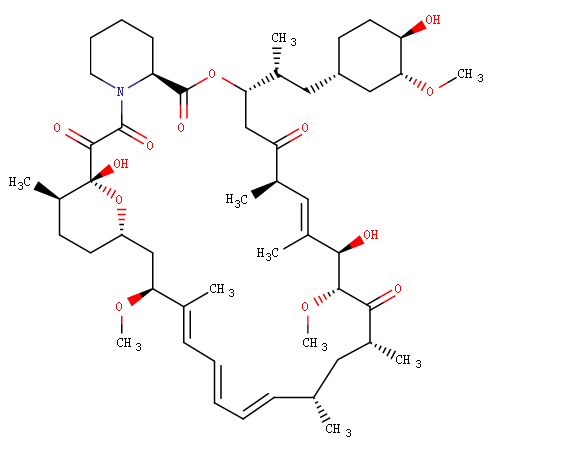Sirolimus
Other name
-
International/Other brands
Rapamune
Groups
Approved
Structure

Prescription products
| Name | Dosage | Strength | Route | Labeller |
|---|---|---|---|---|
| Gd-sirolimus | Tablet | 5 mg | Oral | Genmed A Division Of Pfizer Canada Inc |
| Gd-sirolimus | Solution | 1.0 mg | Oral | Genmed A Division Of Pfizer Canada Inc |
| Gd-sirolimus | Tablet | 2 mg | Oral | Genmed A Division Of Pfizer Canada Inc |
| Gd-sirolimus | Tablet | 1.0 mg | Oral | Genmed A Division Of Pfizer Canada Inc |
| Rapamune | Tablet, coated | 2 mg | Oral | Pfizer |
| Rapamune | Tablet, sugar coated | 1 mg/1 | Oral | Wyeth Pharmaceuticals Inc., a subsidiary of Pfizer Inc. |
| Rapamune | Tablet, sugar coated | 1 mg/1 | Oral | Cardinal Health |
| Rapamune | Tablet | 1.0 mg | Oral | Pfizer |
| Rapamune | Tablet, coated | 0.5 mg | Oral | Pfizer |
| Rapamune | Tablet, coated | 1 mg | Oral | Pfizer |
Target
-
Description
A macrolide compound obtained from Streptomyces hygroscopicus that acts by selectively blocking the transcriptional activation of cytokines thereby inhibiting cytokine production. It is bioactive only when bound to immunophilins. Sirolimus is a potent immunosuppressant and possesses both antifungal and antineoplastic properties.
Indications
Sirolimus inhibits T lymphocyte activation and proliferation that occurs in response to antigenic and cytokine (Interleukin IL-2, IL-4, and IL-15) stimulation by a mechanism that is distinct from that of other immunosuppressants. Sirolimus also inhibits antibody production. In cells, sirolimus binds to the immunophilin, FK Binding Protein-12 (FKBP-12), to generate an immunosuppressive complex. The sirolimus:FKBP-12 complex has no effect on calcineurin activity. This complex binds to and inhibits the activation of the mammalian Target Of Rapamycin (mTOR), a key regulatory kinase. This inhibition suppresses cytokine-driven T-cell proliferation, inhibiting the progression from the G1 to the S phase of the cell cycle.
Other indications
-
Mechaism of action
-
Absorption
-
Metabolism
-
Toxicity
-